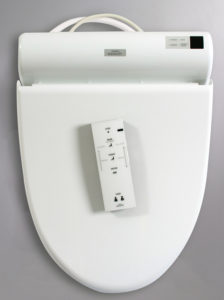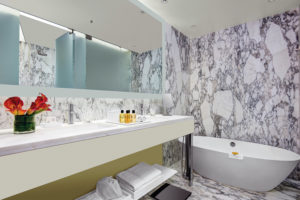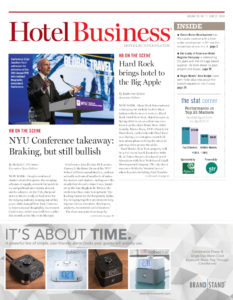In 1906, John Jacob Astor IV, a surname synonymous with luxury and wealth, opened The Knickerbocker hotel. There, lavish parties were held where glamorous women dressed in their pearl necklaces and mink stoles would excuse themselves to the powder room to primp in front of the mirror. In 1921, a year after Prohibition became law, the property closed, bringing the martini-fueled cocktail parties to an end. Now, the legendary New York hotel is back in business and welcoming a new set of stylish, high-heeled women and well-heeled men into redesigned bathrooms adorned with Italian marble and illuminated mirrors.
The entire hotel was renovated in 2013 in a redesign that included the public restrooms, as well as all 330 guest bathrooms. When the property opened in 2015, the lavatories were meant to be a crucial component in overall guest satisfaction. “Hotel bathrooms and bathroom amenities used to be an afterthought. Today, everything is catered towards the ultimate guest experience,” said Shawn Hauver, managing director of The Knickerbocker.
Privacy and luxury are at the heart of the washroom scheme. “A bathroom should allow the guests to feel as if they are walking into a private oasis,” said Michael Gabellini, principal at Gabellini Sheppard Associates, the New York interior design and architectural firm tasked with the revamp. Additionally, The Knickerbocker has a line of in-room bath amenities designed by Ted Gibson.
Gabellini designed the hotel’s interior, while the exterior was left alone to pay homage to the building’s Beaux-Arts facade and rich history. He explained that his overall mandate was to recreate the spirit and “bring the legend and legacy back to The Knickerbocker.”
The bathrooms are designed to bring guests back to the hotel’s storied past while maintaining chic modernity. Gabellini accomplished this by using imported marble and contemporary pieces, including backlit mirrors. “The restroom experience incorporates honed porcelain, marble and illuminated mirror panels emitting a halo of perimeter lighting,” he said.
Marble is an especially consistent component within The Knickerbocker’s bathroom designs. “Reminiscent of the Roman baths, the bathroom experience allows guests to walk into a space carved out of a marble block, continuing the hotel environment, which has been conceived to glow from the inside out,” Gabellini said.
The placement of closets also contributes to the bathroom becoming a centerpiece of the guestroom experience. “By positioning the closet in the middle of the space, the floating armoire concept permits enhanced room movement and amenity placement between sleeping and bathing areas,” Gabellini noted.
During the initial design phase, The Knickerbocker and Gabellini collaborated on a series of design concepts and schemes for each suite. According to Gabellini, the Cohan suite is meant to combine restrained understatement while being playful and effervescent. This carried through to the bathroom with Morado Rosewood floors, which contrast with honed Italian Cervaiole marble. He went on to explain that the Martini suite is bold, smooth, seductive and sensual with supple lighting that complements a washroom made of fandango marble. Book-matched ash paneling and opaque etched glass provide shimmer to accent the space.
Another suite, the Parrish, is whimsical with luminous colors meant to embody a Parisian garret or artisan atelier. “The Italian marble in charcoal gray and green slate slabs in the bathroom complement the lush deep tone-on-tone palette throughout the suite. The opacity of the etched glass allows the glow to act as an accent within the provocative space,” Gabellini said.
The theatrically themed Caruso suite was given special attention in its design. The bathroom is comprised of deeply veined Breccia Capraia marble slabs from Italy, which brings grandeur to the space, said the designer. Regal hints of purple make the design pop. HB
Washlet creates splash in San Fran
SAN FRANCISCO—The Palace Hotel here has forgone the traditional toilet in 30% of its guestrooms, instead opting for a toilet experience with TOTO’s Washlet. And as guest-satisfaction cards have pointed out, guests are taking notice.
“The reaction has been phenomenal. The Washlet has become one of the most talked about luxuries at the Palace Hotel. It has been the topic of social media conversations, colorful Instagram posts and Pinterest pins. It has been amazing to watch, and there is no doubt that this luxury amenity has tremendous novelty appeal,” said Mark Sneen, the hotel’s manager.
 The Washlet features hygienic functions such as a cleansing wand, which pulsates, oscillates and changes temperature.
The Washlet features hygienic functions such as a cleansing wand, which pulsates, oscillates and changes temperature.
“Not only is it comfortable, but it can also get you clean and refreshed after every use,” noted Bill Strang, president of operations and e-commerce for TOTO USA. The Washlet also comes with a heated seat, deodorizer and self-cleaning properties.
The S350e and S300e models use electrolyzed water as a chemical-free disinfectant to clean the wand and bowl before and after use. In another eco-friendly move, the Washlet can reduce water consumption by flushing less toilet paper. “Because we have the bidet dryer feature it gives you the opportunity to reduce or eliminate toilet paper,” Strang said.
“Adding the Washlet to guestrooms was part of a multimillion-dollar renovation,” said Jon Kimball, GM/area managing director, Starwood Hotels & Resorts. “We had planned to feature it only in suites but decided to expand the installation.”


